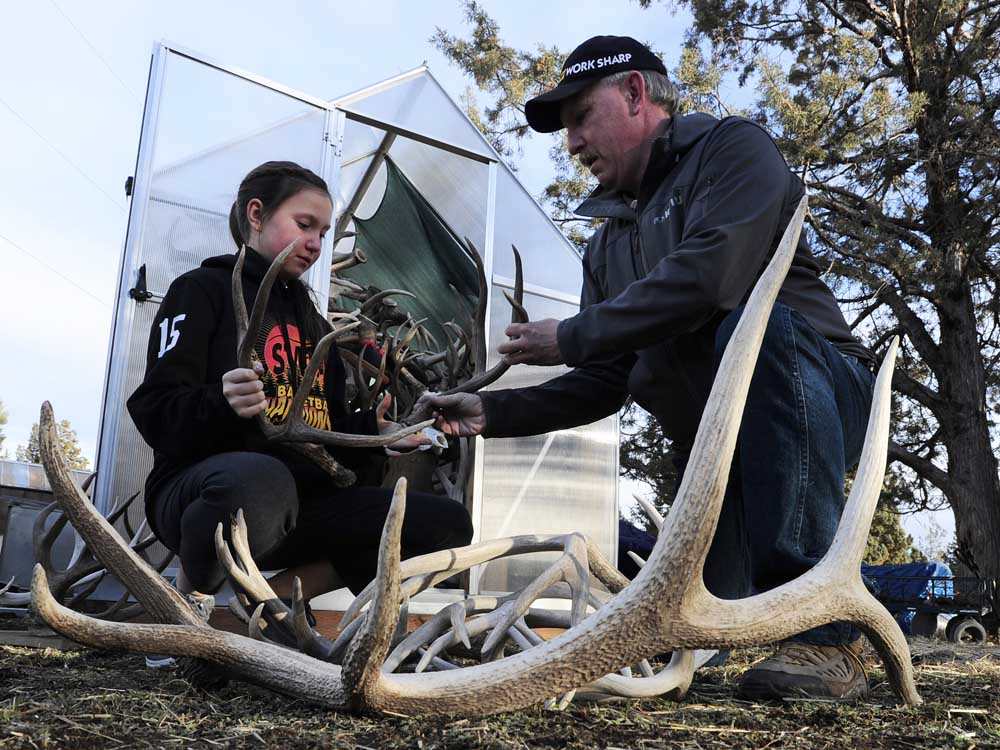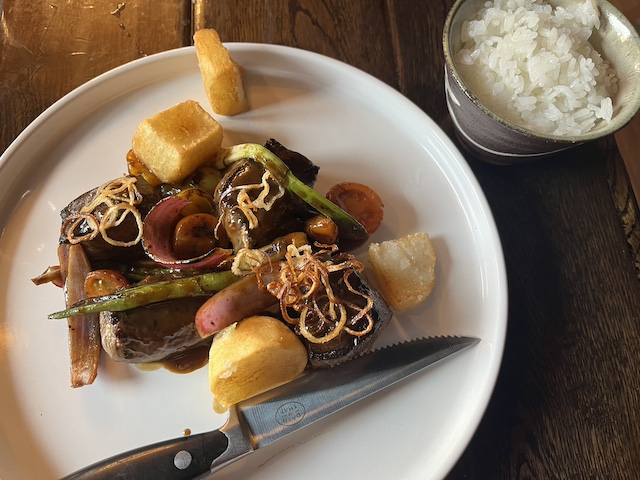Central Oregon antler-shed hunting season postponed by snow
Published 5:56 am Thursday, April 20, 2017

- Troy Capps, a member of Oregon Shed Hunters, and his 11-year-old daughter Brynn look through a portion of the antlers he has found over the years for matching sets at their Terrebonne home March 6. (Ryan Brennecke/Bulletin photo)
Lisa Husaby was jogging with her dog, a French Brittany, when it ducked into a snowy juniper forest north of Bend. Moments later, the dog popped out, cradling a 7-pound, three-point deer-antler shed between its teeth.
Nelli, who finds about three or four sheds a year, trotted the rest of the 40-minute run with the antler in her mouth.
Husaby, by extension of Nelli, is one of countless Central Oregonians who enjoy deer and elk antler-shed hunting.
Fresh sheds, which are brown and rock hard, are the most valuable. The longer a neglected shed lies, the whiter, more brittle and less desirable to collectors it becomes.
Deer bucks shed their antlers from late December through March, and elk bulls part with them from late February through early April, according to the Oregon Department of Fish & Wildlife.
Shed hunters find a variety of uses for the antlers that are painlessly discarded each year. Some artisans fashion antlers into chandeliers or table legs. Others mount them as stand-alone objects on walls or mantles. Still others sell them to companies that chop them down into chewable sizes for dogs.
And while it’s prime shed-hunting season in Central Oregon, the ODFW and local shed-hunting authorities are urging the public to postpone their early-spring scavenger hunt on account of this winter’s historic snowfall.
Deer and elk are still very concentrated because of the snowpack being as thick as it is, said Troy Capps, the co-founder of the Oregon Shed Hunters Association. This season, their wintering range is lower in elevation, having been pushed out to the desert and Bureau of Land Management lands by heavy snowfall.
The Oregon Shed Hunters Association has indefinitely postponed its annual shed hunt, which it typically schedules on the cusp of February and March. The nonprofit had originally rescheduled the hunt to late March, but storms early in the month meant deer and elk have been stuck in their winter ranges longer. As a result, deer and elk are weaker because they’ve exhausted much of the potential food in their wintering range.
Deer and elk eat natural grasses, bitterbrush, sage and juniper berries while they wait for spring greens to emerge, Capps said.
“We really push this point: Let those deer and elk get the feed they need. Don’t be pushing them around. Do the right thing,” said Capps, 55, who’s a science teacher at Terrebonne Community School. Also an avid deer and elk hunter, Capps said respecting the deer and elk during this prolonged and stressful winter season is key to enjoying a healthy stock of deer and elk for their respective hunting seasons this fall.
“The critters need some time,” said association co-founder Rob Tanner. “We were hoping the weather would break, but it’s too soon for us to be having a gathering.”
Not an Easter egg hunt
The association’s shed hunt, which is a 5- to 10-mile hiking and overnight camping event, is enjoyed by 30 to 60 people who fan out across a wide range. It’s like a search party, only for sheds instead of hikers. The hunters spread out in wider fans to ease their presence in the area and to avoid quibbling over a mutually discovered shed.
“You can go for miles and days and not find anything, and then you’ll find some,” Capps said. “It’s not like you pick them up like Easter eggs. They’re tough to find.”
The Shed Hunters Association attracts a variety of Central Oregonians — those who hunt and harvest in the fall and nonhunters, who are similarly drawn to the beauty of the sheds and the prospect of purposeful hiking. Some invite their dogs to help in the hunt.
“Most people are just recreating. Shed hunting gives (people) something to shoot for without shooting,” Tanner said, adding that other hunters use the opportunity to study where deer and elk have wintered and speculate where they might be in the fall.
Oregon has no official laws banning shed hunting during winter months, unlike Utah and Colorado. The ODFW does, however, enact motor-vehicle closures in some of the deer and elk wintering ranges, which in Central Oregon include the Tumalo and Metolius Winter Ranges and the Prineville Reservoir Wildlife Area. The noise of motorized recreation stresses deer and elk and causes them to vacate otherwise ideal wintering spots, said the ODFW.
Both Capps and Tanner, who are brothers-in-law, have secret shed-hunting spots — that coincide with where they harvest them in the fall — they don’t tell anyone about. They’re tucked far into the backcountry, and Capps and Tanner horse-pack it in. They said good spots for beginners to search for sheds include anywhere east of Redmond, Bend and near La Pine. Elk sheds might be found in the foothills near Sisters.
The association admonishes trespassing on private land and confronts off-roaders driving in violation of motor-vehicle closures. In several instances, the organization has tipped off the Oregon State Police.
“My problem is it’s always the people doing the wrong thing that make things change,” Capps said, referring to other states’ shed-hunting bans that are sometimes enacted because of public misconduct. “We’re kind of a watchdog in that sense, too.”
Prized, valuable finds
Although Tanner, 43, began deer hunting when he was a preteen, he got into shed hunting about 10 years later.
“I’ve always had a fascination with antlers. With deer and elk hunting, you have to have a tag, and you only get to hunt (one season) a year. But with shed hunting, you have neither one of (those constraints). I can get my antler fix more often by shed hunting.”
While the Redmond resident does prize a good shed find, Tanner treasures the antlers of the animals he’s hunted for meat.
“There is skill involved in shed hunting, but to hunt them you have to outsmart the animal,” he said.
Tanner and Capps declined to say how many sheds they have collected over their careers, which respectively span two and three decades. They said the nefariously minded might like to help themselves to an ill-gotten payday.
“There’s money in antlers,” Tanner said.
Store-bought sheds
Antler Arts, in Sisters, has been making and selling antler-infused art, furniture and lighting fixtures since 1996. Each year, the store buys 7,000 to 8,000 deer and elk antlers that are mostly sourced in Central Oregon, said manager Ralle Johnson.
Fresh, brown-colored elk and deer sheds go for $10 and $7 per pound, respectively. Elk and deer “chalk” — or old and sun-bleached sheds — go for $2 and $1 per pound. Deer antlers account for about 70 percent of those brought in; elk is more scarce. Owner Wayne Gladden uses 11 “craft-grade” antlers to make a chandelier, which can fetch $3,900. Smaller ticket items include lamps and tables. Antler dog chews range in price from $7 to $8 for small pieces of deer antler and $30 for a large elk piece. Antler whistles cost $5.99.
“There are so many things you can use antlers for. It makes it a cool natural resource,” Johnson said. “Each antler is unique, and if you want to use the word ‘beautiful,’ they are. Their massive beauty is incredible.”
—Reporter: 541-617-7816,
pmadsen@bendbulletin.com
On the web
For more information about Oregon’s Big Game Hunting Regulations as it pertains to shed hunting, visit www.bit.ly/2m6w9tB






